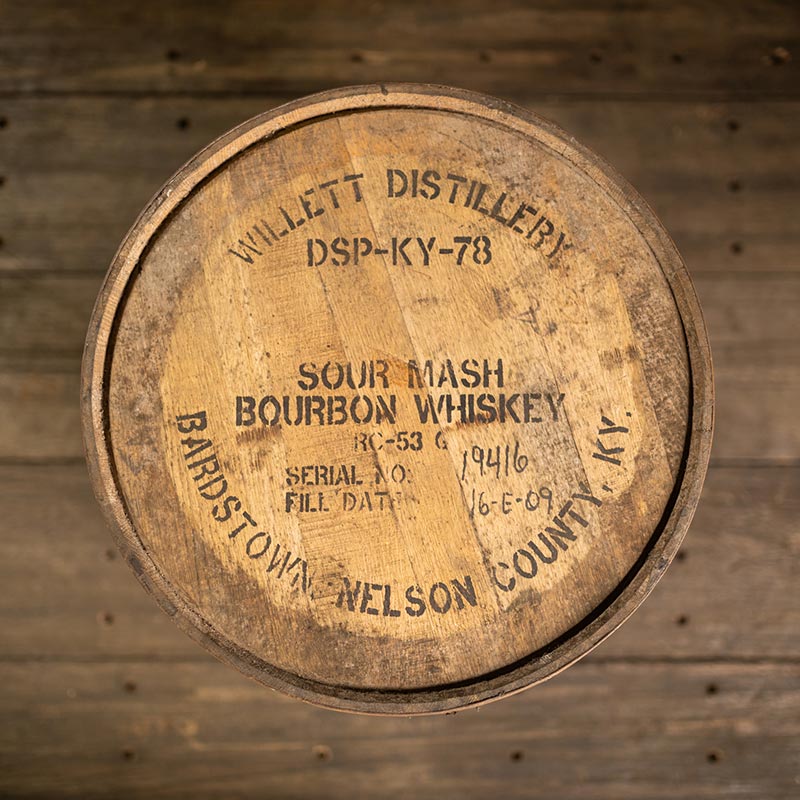Commercial Whiskey Barrel Aging
ULTIMATE OAK BARREL GUIDE: CHOOSE THE RIGHT CASK FOR AGING
DISCOVER THE DIFFERENT TYPES OF OAK BARRELS & HOW THEY INFLUENCE FLAVOR AND QUALITY.
September 18th, 2024

When it comes to aging and flavor, not all oak is created equal. The robust character of American oak and the subtle nuances of the French and Hungarian varieties each bring something unique to the barrel and ultimately to the craft beverages aged in them.
At Midwest Barrel Co., customers frequently ask us about the differences in oak varieties. After being in the barrel industry for nearly 9 years, I wanted to share my thoughts on the nuances of the different oak casks.
american oak
The Rockstars of the Whiskey World


Quercus Alba




If you've sipped on a bourbon and tasted notes of vanilla, caramel, toffee, or even a hint of coconut, you can thank American oak for that. This wood is a powerhouse of flavor, imparting sweet, creamy, and slightly spicy notes to the liquid that it holds.
The presence of lactones in American oak is responsible for those coconut and toasty aromas, while the natural sugars in the wood caramelize during the toasting process, leading to those rich, dessert-like flavors. Smoke and spice notes are often a result of the char level inside the barrel, adding an extra layer of complexity to the final product.
Bourbon, in particular, benefits immensely from the flavor the American oak provides. Willett, a name synonymous with high-quality bourbon, ages its spirits in charred American oak barrels, along with other brands such as Maker's Mark, Wild Turkey, and Jack Daniel's.
Bourbon isn't the only whiskey married to American oak, as many Scotch whisky producers, such as The Macallan and Glenmorangie, also age their spirits in used American oak barrels - often those same barrels that once held bourbon.
french oak
The Gold Standard in Winemaking


Quercus Robur
Quercus Petraea




Quercus Petraea is native to France, with the best specimens often coming from forests like Limousin, Allier, and Vosges. The tight grain allows for a slow, controlled oxygen exchange during aging, giving the wine or spirit time to develop complex flavors without overwhelming it with tannins.
French oak is all about finesse and subtlety. Unlike the bold flavors of American oak, French oak imparts delicate, refined notes to the aging liquid. Expect flavors of soft spice, vanilla, and a hint of toastiness with a smooth, silky texture that enhances rather than overpowers.
The tannins in the French oak are softer and more integrated, making it an excellent choice for wines and spirits that require a gentle touch. The result is a beautifully balanced flavor profile that highlights the natural characteristics of the wine or spirit while adding layers of complexity.
French oak casks have been crucial in creating some of the world's most celebrated wines and spirits. Top-tier Bordeaux wines, like those from Château Margaux and Château Lafite Rothschild, owe part of their complexity and elegance to aging in French oak barrels.
In the spirits world, Cognac producers like Rémy Martin and Hennessy use French oak to create the smooth, luxurious profiles they are known for.
SPANISH OAK
The Backbone of Brandy & Spanish Wine


Quercus Robur
Quercus Petraea
Quercus Pyrenaica




The wood used in Spanish oak casks come primarily from Quercus Pyrenaica, a species native to the Iberian Peninsula, but can also come from Quercus Robur or Quercus Petraea. These trees are known for their dense, tight-grained wood that are rich in tannins. People have long cherished Spanish oak for aging not only fine brandy, but also some of Spain's most celebrated wines from the Rioja region.
Due to the geographical proximity to French oak, Spanish oak barrels have a similar profile, but they add in some smoky and vanilla nuances to the liquid aged in them. It also has more ellagitannins than American oak, but less than French oak, which helps make wine more astringent and stabilize its color.
In the Rioja region of Spain, winemakers age almost all red wines in Spanish oak, particularly "Crianza" level wines. This includes wines from Acontia Wines and Lan 7 Metros.
Other than wine, people widely recognize Spanish brandy for its aging in Spanish oak casks, specifically Brandy de Jerez, which producers make in the Sherry Triangle region of Spain. Lepanto is one of the few that are actually distilled and aged there.
HUNGARIAN OAK
A Balance Between Spice and Structure


Quercus Petraea
Quercus Robur




The wood for Hungarian oak casks come from the same species of trees used for French oak casks, Quercus Patraea and Quercus Robur. Hungary has two oak forests where most of the raw material for coopering comes from: Mecsek and Zemplén. Although it does not have the density of American oak, producers recognize it for its fine, tight grain. The wood's natural tannins, combined with hints of vanilla and clove, add a subtle complexity to the aging process.
While similar to that of French oak barrels, the wood's unique terroir, influenced by the mineral-rich soil of Hungary, contribute to its ability to impart notes of vanilla, cloves, bittersweet chocolate, roasted coffee, and exotic spices. Winemakers in regions such as Tokaj, which surrounds the Zemplén forest, often choose Hungarian oak to age their wines.
Winemakers often age full-bodied red varieties like Malbec, Petite Verdot, and Rhône Valley blends in Hungarian oak barrels. Wineries such as Obsidian Ridge Estate and Royal Tokaji utilize these casks.
Brandy is a popular spirit aged in Hugarian oak barrels, specifically the fruit brandy originating from Hungary, Pálinka. You can find some specialty whiskeys aged in them as well, such as Killowen Irish Blended Whiskey 10 Year Hungarian Oak.
MONGOLIAN oak
A Down-To-Earth Character


Quercus Mongolica






The scientific name for Mongolian oak is Quercus Mongolica, and it's native to regions in East Asia, including parts of Mongolia, China, Korea, Japan, and Russia. Producers know the wood from these trees for its toughness and durability, which makes it an excellent choice for barrel-making. Mongolian oak has a medium-to-coarse grain, which allows for moderate oxygen exchange during aging, giving spirits time to develop rich, layered flavors. The wood's unique growing conditions in the harsh climates of East Asia contribute to its distinctive character and flavor profile.
Mongolian oak imparts a rich, earthy flavor to the spirits it ages, with pronounced tannins and a hint of herbal notes. These barrels are known for adding a robust, almost rugged quality to the liquid inside, with flavors that might include hints of forest floor, dried leaves, and a touch of spice. The strong tannic structure provided by Mongolian oak makes it ideal for spirits that require a bolder profile, adding depth and complexity that can stand up to even the most intense flavors.
While not as widely used as other types of oak, Mongolian oak casks have made their mark in the world of spirits. Some producers in Asia, particularly Japan and China have begun to experiment with Mongolian oak in the aging of whisky and other spirits.
You can find bourbons here in the U.S. participating in the experiment as well, including Old Charter Oak Mongolian Oak released by Buffalo Trace Distillery, and Red Line Whiskey Co.'s Straight Bourbon Whiskey Finished With Mongolian Oak.
MIZUNARA oak
The Unicorn of the Barrel World


Quercus Crispula




Mizunara oak, or Quercus Crispula, is native to the forests of Japan. The trees are slow-growing and can take up to 200 years to reach maturity, which contributes to the rarity of Mizunara barrels. The wood itself is notoriously difficult to work with - it's prone to leaking and requires a high level of craftsmanship to turn into a barrel.
Despite these challenges, the results are well worth the effort. The wood's unique growing conditions in Japan's temperate forests give it a distinctive grain and flavor profile that can't be replicated by any other type of oak.
The flavor profile of Mizunara oak is nothing short of extraordinary. Expect notes of sandalwood, coconut, and oriental spices, with a creamy, almost incense-like quality that's completely unique. The wood imparts a subtle, complex flavor that evolves over time, adding layers of depth and character to the spirit. Mizunara oak barrels are known for their ability to create a truly luxurious drinking experience, with flavors that are both exotic and familiar at the same time.
Mizunara oak casks have become synonymous with some of the most luxurious and rare whiskies in the world. Japanese whisky producers like Suntory and Nikka have used Mizunara casks to create expressions that are revered - and often carry a premium price tag. Mizunara-aged whiskys have also gained popularity outside of Japan, including bourbon expressions such as Angel's Envy's Mizunara Oak Cask Finish and Rabbit Hole Distillery's Mizunara Founder's Collection.
AMBURANA oak
A Touch of South American Flair


Quercus Cearensis




The wood used in Brazilian oak barrels comes from the Amburana Cearensis tree, which is native to the northeastern regions of Brazil. The wood is known for its light color and distinctive grain pattern, which makes it an attractive choice for cooperages. Amburana has been used for centuries in Brazil, not just for aging cacaça, but also in the production of furniture and other goods. The unique growing conditions in Brazil's diverse climate contribute to the wood's distinctive properties, which include a natural resistance to insects and decay.
Brazilian oak imparts a flavor profile that's as vibrant as the country itself. Expect subtle sweetness, with notes of vanilla, cinnamon, and a toasty quality that adds warmth and depth to a spirit. The wood also has a unique spicy character that can give the aged liquid an almost festive quality, reminiscent of baking spices and holiday treats. This combination of sweet and spicy makes Brazilian oak barrels a great choice for aging spirits that benefit from a rich, warm flavor profile, such as whiskey and certain liqueurs.
Cachaça brands like Leblon and Novo Fogo are aged in Brazilian oak, showcasing the wood's ability to add depth and complexity to the national spirit of Brazil. In the world of whiskey, some distillers are beginning to experiment with these casks, creating unique expressions that stand out for their sweet, spicy character. Barrel Bourbon Cask Finish Series: Amburana and NuLu Amburana Finished Bourbon are great examples of this.
Barrels are flavor game-changers. Different woods can drastically alter your spirits and wines. From the sweet notes of American oak to the exotic flavors of Mizunara oak, each wood offers something different to the cask. The key is understanding these differences and choosing the right barrel to get the flavor you're looking for.
Whether you're a distiller, winemaker, or creating something yourself at home - don't hesitate to experiement. In barrel-aging, the options are vast - so dive in and see what you can craft. Cheers!
Speaking of Barrels...
Shop all of our barrels below!

ABOUT THE AUTHOR:
Ben Loseke
Ph.D., and Founder of Midwest Barrel Co. Barrel expert. Plant doctor. American picker. Only known allergies: spicy food and meetings.


























